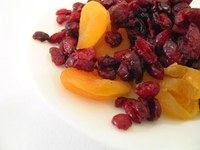Prairie Fare: Honey, You Shrank the Fruit
(Click an image below to view a high-resolution image that can be downloaded)
By Julie Garden-Robinson, Food and Nutrition Specialist
NDSU Extension Service
“I think Dad may be drying socks in the dehydrator next,” our son said with a laugh.
My husband rolled his eyes and glanced in my direction. I think he wanted me to defend him.
Earlier this fall, I bought a new food dehydrator. We had a bumper crop of large apples, and our kids enjoy naturally sweet dried apples as snacks. We made several batches.
One day, I couldn’t find the pineapple I purchased for dinner. I noticed the sound of the food dehydrator humming in the background. Yes, pineapple slices were in the dehydrator that day. The pineapple slices were quite tasty, but they were much smaller.
I didn’t say, “Honey, you shrank the fruit.” My latest kitchen gadget purchase was being used.
I bought some tangerines one evening during a quick stop at the grocery store. You guessed it. Only a few escaped being dehydrated the following day.
“The tangerines were for my lunch,” I noted with exaggerated disappointment. My comment prompted the “sock” comment from our son.
One of our daughters plucked a tiny piece of dried tangerine from the tray and examined it as though she were a food critic. She defended her dad, saying, “These tangerines have a highly interesting texture and flavor.” I’m not sure why she made her comment in a fake British accent, but we all laughed.
“I’m glad you’re using the dehydrator. Please keep using it,” I said to my husband. We were teasing him a bit too much that day.
Dehydration has been a method of preserving food since early history when refrigerators and freezers were not available to help prevent food spoilage. Dehydration allowed people to have portable, lightweight and safe food to enjoy throughout the year.
Many types of dehydrated foods are available, including raisins, prunes, jerky and dried vegetables used in “instant soups.”
Dehydration probably was discovered by accident when early civilizations left food out in the sun and wind. Dried food will not spoil as quickly because bacteria and other organisms need some moisture to grow. Mold, however, grows on foods with little moisture.
Because of the renewed interest in gardening and local food production, food preservation has increased in popularity. Food varies in moisture content and density, so dehydration is less precise than other types of food preservation.
Drying fruit is a good place to start, but be aware that fruits require various preparation steps prior to drying. For example, apples turn brown (oxidize) readily when their flesh is exposed to oxygen after peeling. Therefore, they need to be treated with an antioxidant, such as a citric acid or ascorbic acid (vitamin C) mixture. These powders can be purchased in the canning section in many grocery stores.
Fruit juice dips, such as orange juice or lemon juice, can be used to pretreat fruit prior to drying, but they do not work as well as the powdered versions of the natural acids they contain.
Heat also can be used to help prevent browning. For example, syrup blanching and steam blanching can be effective in maintaining the quality of fruit during the drying process.
Fruit leathers are fun to make with kids. You can start with apple sauce with a little cinnamon to make your own sweet treat at a low cost. Berry leather is another tasty treat that is fun to make with kids. Although ovens at low temperatures for long periods of time can be used to dehydrate foods, food dehydrators are a safer option when working with children.
The following fruits were rated as “excellent” or “good” by the University of Georgia for preparing fruit leather: apples, apricots, berries, cherries, nectarines, peaches, pears, pineapple, plums and strawberries. Other fruits (blueberries, cranberries) in combination can provide a good end product, too.
Visit https://www.ag.ndsu.edu/food for three fact sheets about drying food. Click on “Food Preservation” then “Drying” to access the information.
Here’s a recipe from the National Center for Home Food Preservation. Drying fruit leather works best in a food dehydrator, but an oven can be used as directed in the recipe. Pumpkin is high in beta-carotene, which our bodies convert to vitamin A.
This vitamin helps keep our skin healthy and helps prevent night blindness.
Pumpkin Leather
2 c. canned pumpkin (or 2 c. fresh pumpkin, cooked and pureed)
1/2 c. honey
1/4 tsp. cinnamon
1/8 tsp. nutmeg
1/8 tsp. ground cloves
Blend ingredients well. Spread 1/8 inch deep on trays with sides or cookie sheets with sides. Line the trays or cookie sheets with plastic wrap. Avoid getting the leather too close to the edge to avoid spilling. Dry at 140 F in a food dehydrator or in an oven. If you use your oven, check the settings to see if has a setting as low as 140 F. If your oven cannot be set this low, your food will cook instead of drying. For air circulation, leave the oven door open 2 to 6 inches.
Note: Oven drying may not be safe if you have young children or pets in the house. If you try it, be sure that children and pets are kept away from the oven.
Test for dryness by touching the center of the leather. Fruit leather will take up to eight hours to dry in a food dehydrator or up to 18 hours to dry in a low-heat oven. While warm, peel the fruit leather from the plastic and roll. Allow the roll to cool and rewrap the roll in plastic. If desired, use cookie cutters to cut into appealing shapes for children. Wrap in plastic. The leather will keep up to one month at room temperature or up to one year if wrapped in freezer wrap or plastic freezer bags.
Makes eight servings. Each serving has 90 calories, 0 grams (g) fat, 22 g carbohydrate, less than 1 g protein, 2 g fiber and more than a full day’s recommendation for vitamin A (as beta-carotene).
(Julie Garden-Robinson, Ph.D., R.D., L.R.D., is a North Dakota State University Extension Service food and nutrition specialist and professor in the Department of Health, Nutrition and Exercise Sciences.)
NDSU Agriculture Communication - Oct. 29, 2015
| Source: | Julie Garden-Robinson, (701) 231-7187, julie.garden-robinson@ndsu.edu |
|---|---|
| Editor: | Ellen Crawford, (701) 231-5391, ellen.crawford@ndsu.edu |



